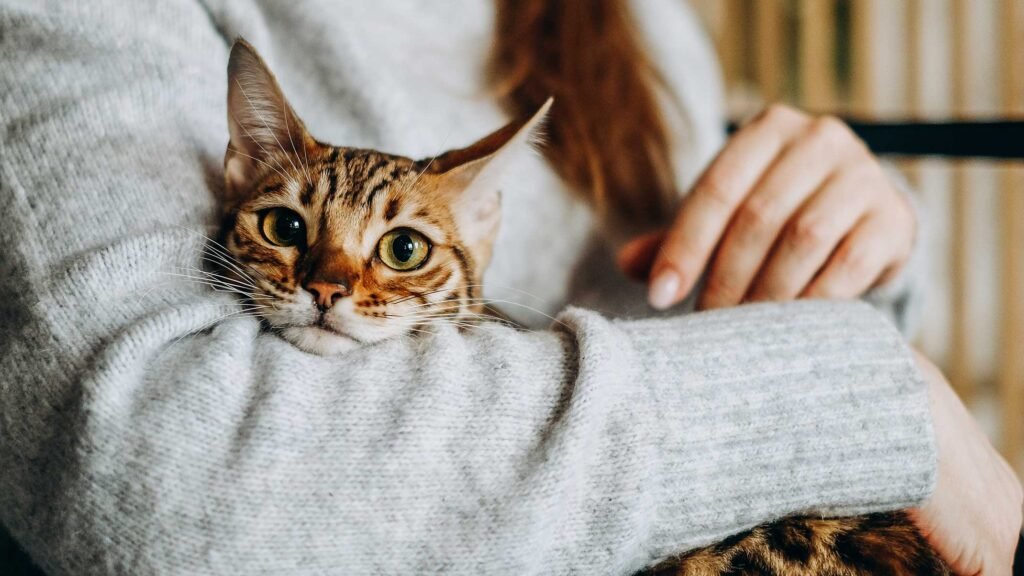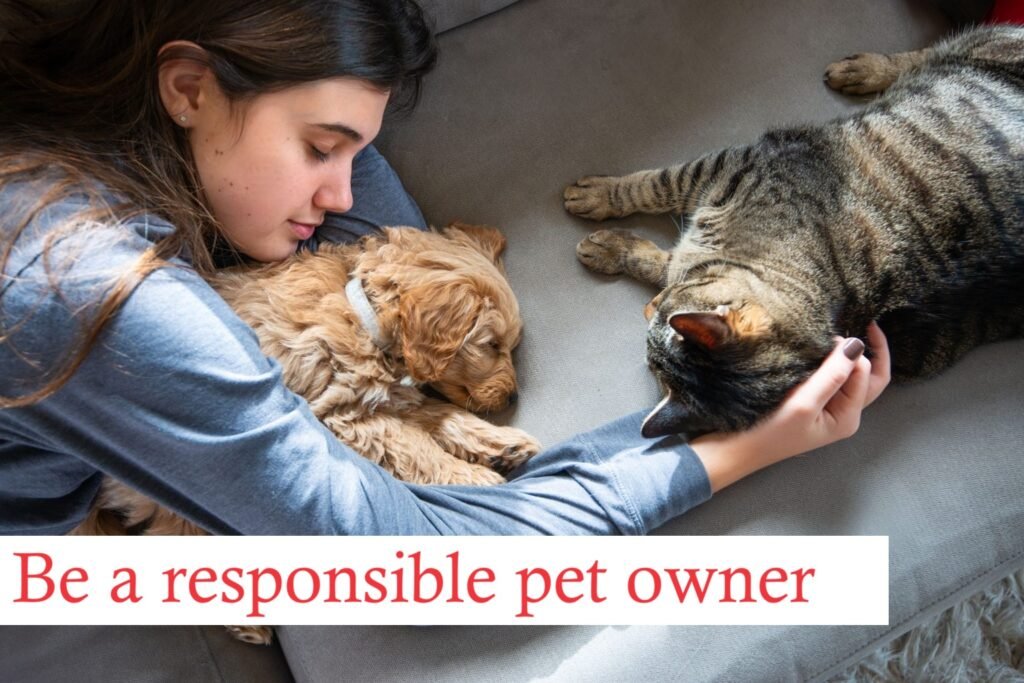Owning a cat brings joy and warmth to any home with their playful antics and affectionate nature. But being a responsible cat owner involves more than just cuddles and treats. It means taking on key responsibilities to ensure your feline friend lives a happy and healthy life.
Here are some key responsibilities every cat lover should know in 2024.
Providing Proper Food
Your cat’s health depends on their food’s nutrients. Always give high-quality food to your cats that fulfills their appetite. Do not only focus on providing high-quality food, but also keep in mind that clean and clear water is a basic need for cats. Moreover, don’t give them human food, especially things like chocolate and onions, which can be harmful to cats.
Tips for Proper Food
- Good Quality Cat Food: Choose brands that prepare food with lots of protein and fewer fillers. Check their labels, and avoid those with many artificial ingredients. Ask your vet to make sure this food is right for your cat’s needs.
- Provide Fresh Water: Always provide your cat with clean, fresh water. Change the water daily to keep it fresh and germ-free. Use a water fountain to help your cat drink more water.
- Avoid Human Food: Some human foods are harmful to cats. To keep them safe, stick to cat food. Even small amounts of some foods can be toxic, so it’s best not to share your meals with your cat.
Regular Vet Visits
Regular vet visits are important. Take your cat to the vet yearly for shots, health checks, and dental care. Finding health problems early can protect your cat from pain and save you money.
Benefits of Regular Vet Visits
- Shots: Keep your cat safe from common illnesses. Vaccinations are essential for preventing illnesses like rabies and feline leukemia. Staying up-to-date with shots is a vital part of pet care.
- Health Checks: Early detection of illnesses can lead to better treatment. Regular check-ups can catch issues before they become serious. This helps your cat live a longer, healthier life.
- Dental Care: Regular vet visits can prevent painful dental issues. Your vet can clean your cat’s teeth and check for signs of dental disease. Good oral health is important for your cat’s overall well-being.
Creating a safe Home
Your home should be safe for your cat. Remove harmful plants or objects. Make sure windows and balconies are secure to prevent accidents. A safe home lets your cat explore and play without risk.
Steps to Create a Safe Home
- Remove Harmful Plants: Some plants are toxic to cats. Keep them out of reach. Examples include lilies, poinsettias, and aloe vera, which can cause serious health problems.
- Secure Windows and Balconies: Securing these areas will prevent falls and escapes. Use screens or barriers to keep your cat safe. This is especially important if you live in a high-rise building.
- Eliminate small hazards: Remove small objects that could be swallowed or cause injury. Items like rubber bands, paper clips, and small toys can be dangerous. Always keep such objects out of your cat’s reach.
Providing Mental and Physical Stimulation
Cats need both mental and physical activity. Provide toys, scratching posts, and climbing trees. Play with your cat regularly. This keeps them active and strengthens your bond.
Ways to Stimulate Your Cat
- Interactive Toys: Toys that move or make noise can keep your cat engaged. Laser pointers, feather wands, and puzzle toys are excellent options. Rotate toys regularly to keep things interesting.
- Scratching Posts: These help keep their claws healthy and prevent furniture damage. Place scratching posts in areas your cat frequents. Encourage use by rubbing catnip on the post.
- Climbing Trees: Cats love to climb. Ensure that they have safe climbing structures. Cat trees, shelves, and perches provide places to explore and rest.
- Daily Playtime: Spend time playing with your cat to keep them active and happy. Use a variety of toys to engage their hunting instincts. Play sessions help reduce stress and prevent boredom.
Keeping the Litter Box Clean
A clean litter box is essential. Scoop the litter daily and change it completely at least once a week. Place the litter box in a quiet, accessible location. A dirty litter box can lead to health problems and unwanted behaviors.
Tips for Litter Box Maintenance
- Daily Scooping: To keep the box clean and odor-free, remove waste on a daily basis. This helps prevent litter box aversion. A clean litter box encourages positive bathroom habits.
- Weekly Cleaning: Each week, change the litter and clean the box thoroughly. Use mild soap and water to clean the box. Regular cleaning prevents the buildup of bacteria and odors.
- Quiet Location: For your cat’s comfort, place the litter box in a quiet, low-traffic area. Avoid placing it near loud appliances or in busy areas. A private spot helps your cat feel secure when using the box.
Grooming and Hygiene
Grooming is important for your cat’s hygiene. Brush your cat regularly to reduce shedding and prevent matting. Check their ears, teeth, and nails. Regular grooming sessions also provide an opportunity to check for any signs of illness.
Grooming Tips
- Regular Brushing: This helps prevent matting and reduces shedding. Use a brush suitable for your cat’s fur type. Regular brushing also reduces the risk of hairballs.
- Ear Checks: Look for signs of infection or mites. Clean your cat’s ears with a vet-approved solution. Regular ear checks can help prevent ear infections.
- Dental Care: Brush your cat’s teeth or provide dental treats to keep their mouth healthy. Dental disease is common in cats, so regular care is important. Dental chews and toys can also help maintain oral health.
- Nail Trimming: Keep your cat’s nails trimmed to prevent overgrowth and injury. Use cat nail clippers, and be careful not to cut too short. Regular trimming reduces the risk of scratches and damage to furniture.
Providing Companionship
Cats are social animals. Spend quality time with your cat every day. Cuddling, petting, and talking to your cat helps them feel loved and secure. Cats can get lonely, so your presence and attention are vital.
Ways to Provide Companionship
- Cuddling and Petting: Physical affection helps your cat feel loved. Many cats appreciate your touch and actively seek it out. This physical closeness strengthens your bond.
- Talking to Your Cat: Your voice can be soothing and comforting to your cat. Talk to your cat throughout the day. Even simple conversations can make your cat feel connected to you.
- Interactive Play: Spend time each day playing with your cat to build a strong bond. Play sessions are not only enjoyable but also important for your cat’s health. To engage your cat in playful activities, use toys.
Understanding Your Cat’s Behavior
Learn to understand your cat’s behavior and body language. This helps identify their needs and any potential issues. For instance, hiding might indicate stress or illness, while purring usually means contentment.
Interpreting Cat Behavior
- Purring: Purring frequently signifies contentment and relaxation. Cats purr when they are content and comfortable. Sometimes, cats also purr when they are in pain, so be observant.
- Hiding: It can indicate stress, fear, or illness. If this behavior changes, watch closely. If your cat hides more than usual, it’s a beneficial idea to consult your vet.
- Meowing: Different types of meows can indicate hunger, attention-seeking, or discomfort. Learn the different sounds your cat makes. Each meow can mean something specific.
- Tail Movements: A cat’s tail can tell you a lot. A high, straight tail often means a contented cat. A low or tucked tail can indicate fear or anxiety. Pay attention to these signals.
Ensuring Proper Identification
Your cat should have proper identification. If your cat becomes lost, a collar with an ID tag and a microchip enhances the likelihood of their recovery. Ensure the contact information is always up-to-date.
Identification Tips
- ID Tag: Attach a tag with your contact information to your cat’s collar. If they find your cat, this is the first thing people will look for. Make sure the information is easy to read.
- Microchip: Have your cat microchipped as a backup in case the collar is lost. A vet can scan the chip to find your contact details. Microchipping provides a permanent form of identification.
- Updated Information: Keep your contact details up to date with the microchip registry. If you move or change phone numbers, update the information. This guarantees that people can contact you if they find your cat.
Preparing for Emergencies
Be prepared for emergencies. Have a first-aid kit for your cat, and know where the nearest emergency vet clinic is. Keep a carrier ready for quick trips to the vet.
Emergency Preparedness
- First-Aid Kit: Include bandages, antiseptic wipes, and any necessary medications. A first-aid kit can help you handle minor injuries. Keep it in an accessible place.
- Emergency Vet Location: Know the address and phone number of the nearest emergency vet. Save the contact information on your phone. Quick access to a vet can be crucial in an emergency.
- Carrier: Keep a sturdy carrier available for quick and safe transport. A carrier is essential for vet visits and emergencies. Make sure it is comfortable for your cat.
Dealing with Behavioral Issues
Understanding and addressing behavioral issues is part of being a responsible cat owner. Sometimes, cats may display unwanted behaviors like scratching furniture or spraying. Address these issues calmly and seek advice if needed.
Common Behavioral Issues and Solutions
- Scratching Furniture: To satisfy this natural behavior, provide plenty of scratching posts and pads. Place them near areas where your cat likes to scratch. Encourage use with treats or catnip.
- Spraying: This can be a sign of stress or marking territory. Make sure your cat undergoes neutering, and seek advice from a veterinarian if the behavior continues. To remove the scent, thoroughly clean the sprayed area.
- Aggression: If your cat shows signs of aggression, it might be due to fear or pain. Observe their behavior and ask a veterinarian for advice. Addressing the root cause can help manage aggression.
Socializing Your Cat
Socializing your cat, especially if they are a kitten, helps them become well-adjusted pets. Gradually introduce them to a variety of people, environments, and experiences. This helps reduce fear and anxiety in new situations.
Tips for Socializing
- Introduce Gradually: Slowly introduce new experiences and people. Allow your cat to explore at their own pace. Don’t force interactions if your cat is scared.
- Positive Reinforcement: During socialization, reward your cat with treats and praise. This creates positive associations with new experiences. Use treats to encourage calm and curious behavior.
- Create Positive Experiences: Make sure that your new experiences are positive and stress-free. Keep introductions short and sweet. You should gradually increase the time and intensity of new experiences.
Maintaining a Routine
Cats thrive on routine. Keeping a consistent schedule for feeding, playtime, and grooming helps your cat feel secure. Changes in routine can cause stress, so try to stick to a regular schedule.
Routine Tips
- Consistent Feeding Times: Feed your cat at the same time every day. This helps regulate their appetite and digestion. Predictable meal times make your cat feel secure.
- Regular Playtime: Each day, set aside time for interactive play. A consistent play schedule keeps your cat active and engaged. It also helps burn off excess energy.
- Routine Grooming: To build a habit, regularly groom your cat at the same time each week. Predictable grooming sessions make the process easier for both you and your cat. Regular grooming helps maintain their coat and skin health.
Providing Comfort and Warmth
Ensure your cat has a comfortable place to sleep. Cats love warm, cozy spots. Provide soft bedding, and consider placing it in a quiet, warm area of your home.
Comfort Tips
- Soft Bedding: For your cat, provide a soft, warm bed. Look for beds with removable, washable covers. Comfortable bedding helps your cat feel secure.
- Quiet Space: Place the bed in a quiet, low-traffic area. This provides a safe retreat for your cat when they need rest. A quiet spot helps your cat sleep better.
- Warmth: Cats love warmth. Ensure that their sleeping area is not a drafty or cold spot. Consider providing a heated bed or blanket in colder weather.
Spending quality time
Spending quality time with your cat is crucial. Play, cuddle, and simply be with them. Your cat will appreciate your attention, and it helps build a strong bond between you two.
Ways to Spend Quality Time
- Play Games: Use toys to play games with your cat. It keeps them active and entertained. Simple games like chasing a string or laser pointer can be tremendous fun.
- Cuddle Time: Spend time cuddling with your cat. It helps them feel loved and secure. Gentle petting and holding can strengthen your bond.
- Talk to Your Cat: Talking to your cat can be soothing for them. They enjoy hearing your voice. Regular interactions help your cat feel more connected to you.
Encouraging Exercise
Keeping your cat active is important for their health. Encourage exercise by playing and providing climbing structures. Active cats are healthier and happier.
Exercise Tips
- Play Sessions: Dedicate time each day to play with your cat. To engage their hunting instincts, use toys that mimic prey. Regular play helps prevent obesity and boredom.
- Climbing Structures: Provide cat trees or climbing shelves. Cats love to climb and explore. Vertical space can help satisfy their natural instincts.
- Chasing Toys: Use items that your cat can chase to encourage movement. Feather wands, balls, and laser pointers are excellent options. Chasing toys helps keep your cat fit and active.



